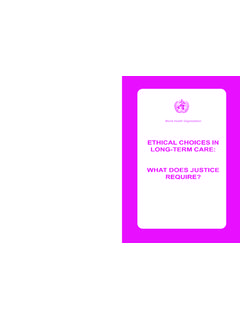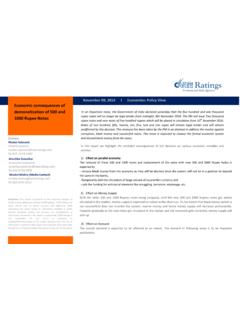Transcription of FRAUD AND ABUSE IN MANAGED LONG TERM CARE
1 FRAUD AND ABUSE IN MANAGED . long TERM care . JAMES G. SHEEHAN. Chief Integrity Officer New york city Human Resources Administration 212-274-5600. LEARNING OBJECTIVES FROM THIS. PRESENTATION. Understand which states are involved in MLTC. Players, structure and payment methodology of MANAGED long -term care ( MLTC ). Understand and identify FRAUD and ABUSE risks in MLTC business model. Understand legal theory of liability/prosecution for MLTC and provider FRAUD and ABUSE . Understand investigative techniques and opportunities for MLTC. long TERM MANAGED care . COMING SOON TO YOUR STATE. As of May 2012, 16 states were using MANAGED care plans to provide long -term care in their Medicaid programs (only 8 states had mandatory programs). By 2014, the number of States projected to have MLTSS. programs is 26. This is based on states that have actually completed planning documents and submitted formal proposals or waiver applications to CMS.
2 Information/By-Topics/Delivery- Systems/Downloads/MLTSSP_White_paper_com bined. pdf (paper attached). COMING SOON OR ALREADY THERE. WHAT 2014 MLTC LOOKS LIKE. MAJOR PLAYERS IN MLTC MARKET. Presence of Leading National Health Plans in MLTSS. Market AZ, DE, FL, HI, MA, NM, NY, TN, TX, WA. United Healthcare - 8. Amerigroup (AI) - 5. Centene - 3. Molina Healthcare - 2. MLTC TAKEAWAYS. Rapid expansion of population over next two years. Large number of new states and new programs. Significant opportunities for cost savings, care and care coordination improvement. Variations in services available and population served. WHAT IS THIS PROGRAM? MANAGED long -term care plans provide long -term care services (like home health and nursing home care ) and ancillary and ambulatory services (including dentistry, and medical equipment), and receive Medicaid payment.
3 Members get services from their primary care physicians and inpatient hospital services using their Medicaid and/or Medicare cards. Members must be eligible for nursing home admission. Most MANAGED long -term care plan enrollees must be at least age 65 . WHAT IS THIS PROGRAM (NY). Medicaid Section 1115 Demonstration waiver .. Require(s) all dual-eligible individuals (persons in receipt of both Medicare and Medicaid) who are aged 21 or older and are in need of community-based long term care services for more than 120 days to be enrolled. If you are a Medicaid recipient in NYC who meets the criteria above you must receive those services through a MLTC plan.. (over 35 plans in New york ). There are no Federal marketing guidelines for Medicaid MLTC organizations. PACE ORGANIZATIONS. (PROGRAM FOR ALL-INCLUSIVE care FOR THE. ELDERLY). PACE Organizations A PACE organization provides a comprehensive system of all required health care services in return for capitation for members otherwise eligible for nursing home admission Primary care Inpatient hospital long -term care Must use PACE physicians Both Medicare and Medicaid pay for PACE services The PACE is approved by the Centers for Medicare and Medicaid Services.
4 DRAFT MARKETING GUIDELINES FOR PACE ORGANIZATIONS: Topics/ long -Term-Services-and-Support/In tegrating- care /Program-of-All- Inclusive- care -for-the-Elderly-PACE/Down loads/PACE-Marketing- THE MANAGED long TERM care . CONTRACT. Sample: New Jersey Pilot Discussion New york e/mltc/ FRAUD AND ABUSE RISKS IN LTMC. Cherry-picking healthy enrollees. Refusing to enroll individuals with likely upcoming expenses. Falsifying enrollment information to support higher capitation rates, or reporting patients as nursing home eligible when they are not. Disenrolling expensive patients. Pressuring nursing homes to certify permanent placement . Delaying eligibility determinations on newly discharged hospital patients. Denying medically necessary care . Contracting with unlicensed or unqualified providers. Providing worthless services . CONTRACT PROVISIONS. The contractor will evaluate all applicants to assess that they are expected to require at least one of the following services and care management for at least 120 days from the effective date of enrollment: Nursing services in the home.
5 Therapies in the home. Home health aide services. Personal care services in the home. Adult day health care , or Social day care if used as a substitute for in-home personal care services. The potential that an Applicant may require acute hospital inpatient Services or nursing home placement during such 120 day period shall not be taken into consideration by the Contractor when assessing an Applicant's eligibility for enrollment. CLIENT EVALUATION. Performed by the MLTC contractor. Evaluation drives. Eligibility for enrollment. The Contractor, using the patient assessment instrument specified by the Department, will evaluate all Applicants to assess their eligibility for nursing home level of care as of the time of enrollment . Capitation rate In New york evaluation by contractor using Semi-Annual Assessment of Members (SAAM) is audited only once in six years by state.
6 New york now plans to replace SAAM with instrument not yet developed, the Uniform Assessment System-New york (UAS-NY). In other states ( , Wisconsin) centralized enrollment. CLIENT EVALUATION. WHERE THERE IS ASSESSMENT BY A BILLER, THERE WILL BE INFLATED ASSESSMENTS. OIG study: SNFs increasingly billed Medicare for higher paying RUGs even though beneficiary characteristics were unchanged. Payment for ultra high therapy increased nearly 90%. from 2006 to 2008, from $ billion to $ billion. Source: OIG Report: Questionable Billing by Skilled Nursing Facilities (12-22-10). LEGAL THEORIES OF LIABILITY FOR. MLTC. United States ex rel. Tyson v. Amerigroup Illinois, Inc., 488 F. Supp. 2d 719 ( Ill 2007). Fraudulent inducement theory: (1) signing the 2000 MCO Contract (which included a marketing restriction against health-based discrimination) and (2) stating in a letter that "AMERICAID will not discriminate against clients with health issues which includes pregnant women.
7 LEGAL THEORIES OF LIABILITY FOR LTMC. Fraudulent Inducement: Plaintiffs presented sufficient evidence for a reasonable jury to have found that the non-discrimination provisions were conditions to participation. "If a false statement is integral to a causal chain leading to payment, it is irrelevant how the federal bureaucracy has apportioned the statements among layers of paperwork. Tyson LEGAL THEORIES OF LIABILITY FOR. MLTC. Fraudulent Inducement: (1) the nondiscrimination provisions were prerequisites to participation in the Medicaid HMO. program under federal law, see 42 . 1396(m)(2)(A)(v); (2) that AI knew about the nondiscrimination provisions and statutes and told IDPA that it would comply with them; and (3) that Amerigroup planned to violate (and was already violating) the non-discrimination provisions. Tyson at 726. LEGAL THEORIES OF LIABILITY FOR.
8 MLTC. Implied Certification Theory: "a condition to participation is a condition to payment", as "if we held that conditions of participation were not conditions of payment, there would be no conditions of payment at all." Hendow, 461 at 1174-76; see also No. 345, 99th Cong., 2d Sess. at 9, reprinted in 1986 5266, 5274 ("claims may be false even though the services are provided as claimed if, for example, the claimant is ineligible to participate in the program"). Additionally, the nondiscrimination provisions were material because they formed the actuarial basis upon which capitation rates were calculated. Tyson at 727. the IDPA's certification of compliance with applicable laws and regulations (false because of AI's conduct) was material to the United State's decision to pay. Tyson at 728. LEGAL THEORIES OF LIABILITY FOR MLTC - YELLOW FLAG. United States ex rel.
9 Wilkins v. United Health Group, 659 295 (3d Cir. 2011), the relators alleged that their employer had knowingly violated several Medicare marketing regulations. Id. at 300. Proceeding under an implied certification theory, the Third Circuit cautioned that it "should not be applied expansively, particularly when advanced on the basis of FCA. allegations arising from the Government's payment of claims under federally funded health care programs." Id. at 307. It held that the alleged violations of Medicare marketing regulations were not conditions of payment, but rather conditions of participation. Id. at 309. The court further noted that the relators had failed to cite to any regulation demonstrating that a participant's compliance with Medicare marketing regulations was a condition for its receipt of payment from the government. Id. at 309-10. Indeed, the court found that while the government considered substantial compliance with marketing regulations a condition of ongoing participation, it did not require absolute compliance for receiving Medicare payments for services rendered.
10 Id. at 310. NONCOMPLIANCE VS. CERTIFICATION. the False Claims Act claim in this case is not premised on noncompliance with the PDE requirements, but rather the false certification of compliance under 42 505(k). CMS's Prescription Drug Benefit Manual specifically envisions False Claims Act liability for the certification and submission of inaccurate or false PDE data. In the absence of such liability, a subcontractor to a Part D Sponsor in this case, Defendants "would be virtually unfettered in its ability to receive funds from the government while flouting the law." United States v. Educ. Mgmt. Corp., ___ F. Supp. 2d ___, 2012 WL 1658482, at *20 ( Pa. May 11, 2012).. USA ex rel Spay v. CVS (attached). Need to examine contract closely to identify certification claim. LOOK TO YOUR CERTIFICATIONS. Covered services provided by the Contractor under this Contract shall comply with all standards of the New york State Medicaid Plan established pursuant to Section 363-a of the State Social Services Law and satisfy all other applicable requirements of State Social Services and Public Health Law.


















